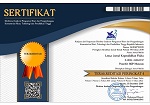Uji Biokompatibilitas Nanofiber Komposit Kitosan/PVA Sebagai Pembalut Luka
DOI:
https://doi.org/10.33394/j-lkf.v6i1.934Keywords:
Nanofiber, Wounds, Chitosan, BiocompatibilityAbstract
[Title: Chitosan/PVA Composite Nanofiber Biocompatibility Test as a Wound Wrap]. This study aims to make chitosan-based nanofiber from NTB local crab shells. The manufacture of nonofiber is intended for application in the medical world as wound dressing. Wound dressing was developed from the basic ingredients of chitosan from NTB local crab shells. This research was conducted using the electrospining method, namely by making fibers from nano-sized chitosan. The resulting wound dressing was analyzed using FTIR. The results of this analysis show that chitosan has an area of absorption or transmittance in some chitosan groups so that it shows a positive alloy on chitosan and PVA as antibacterial in wound dressing.References
Ahmed S., Ahmad M., (2016), Chitosan Based Dressing for Woung Care, Immunochemistry& Immunopath ology, http.//: dx.doi.org.
Charernsriwilaiwat, N., Opanasopit, P., Rojanarata, Th., Ngawhirunpat, T., Supaphol, P. (2010). Preparation and characterization of chitosanhydroxy benzotriazole/polyvinyl alcohol blend nanofibers by the electrospinning technique, Carbohydrate Polymers 81, 675–680
Ciechanska, D. (2004). Multifungsional Selulosa bakteri/Chitosan Composite Materials for Medical Applications. Fibres & Textiles in Eastern Europe.
Elsabee, M.Z., Naguib, H.F., Morsi, R.E., (2012). Chitosan based nanofibers review. Materials Science and Engineering: C 32, 1711–1726.
Hoenich, N. (2006). Cellulose for Medical Applications. Bioresources.
Huang et al., (2003), A Review on Polymer Nanofibers by Electrospining and Their Applications in Nanocomposite, Composites Science and Technology
Lestari Indah. (2018). Uji Mekanik Membran Kitosan Berbahan Dasar Cangkang Kepiting: Mataram
Ramakrishna S., R. Jose, P.S. Archana, A.S. Nair, R. Balamurugan, J. Venugopal, W. E. Teo, (2010), Science and engineering of electrospun nanofibers for advances in clean energy, water filtration and regenerative medicine, J. Mater. Sci, vol. 45, pp. 6283–6312.
Shi X., Zhou W., Ma D., Ma Q., Bridges D., (2015), Electrospinning of Nanofibers and Their Applications for energy Devise, Hindawi Publishing Corporation, Journal of Nanomaterials.
Voudrias E., Fytianos F., Bozani E., (2002), Sorption Description isotherms of Dyes from
aqueous solutions and Waste Waters with Different Sorbent materials, Global Nest, The Int.J, 4(1),75-83
Downloads
Published
How to Cite
Issue
Section
License
Authors who publish with Lensa: Jurnal Kependidikan Fisika agree to the following terms:
- For all articles published in Lensa: Jurnal Kependidikan Fisika, copyright is retained by the authors. Authors give permission to the publisher to announce the work with conditions. When the manuscript is accepted for publication, the authors agree to automatic transfer of the publishing right to the publisher.
- Authors retain copyright and grant the journal right of first publication with the work simultaneously licensed under a Creative Commons Attribution-ShareAlike 4.0 International License that allows others to share the work with an acknowledgment of the work's authorship and initial publication in this journal.
- Authors are able to enter into separate, additional contractual arrangements for the non-exclusive distribution of the journal's published version of the work (e.g., post it to an institutional repository or publish it in a book), with an acknowledgment of its initial publication in this journal.
- Authors are permitted and encouraged to post their work online (e.g., in institutional repositories or on their website) prior to and during the submission process, as it can lead to productive exchanges, as well as earlier and greater citation of published work (See The Effect of Open Access).

This work is licensed under a Creative Commons Attribution-ShareAlike 4.0 International License.



